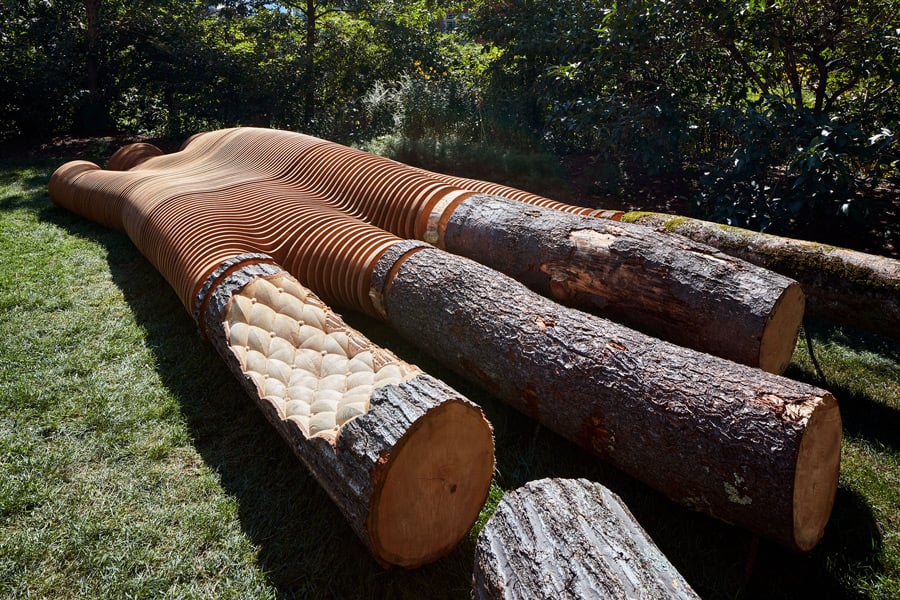
September 29, 2017
Material Experimentation Drives This Year’s Design Biennial Boston
Four large installations include CNC-milled wood, a vinyl-sided “forest,” an aluminum mesh canopy, and more.

Design Biennial Boston, now in its fifth iteration, doesn’t adhere to a particular theme. Over the past ten years, the show (which was founded by the well-regarded architecture gallery pinkcomma) has evolved from a showcase for local designers to a prestigious launching pad for members of the region’s growing architecture community.
Installed along the Rose Kennedy Greenway, an urban-planning attempt to soften Boston’s heavily trafficked downtown by sandwiching a skinny pedestrian park between two busy streets, this is a tight, intimate showing of four top designers and architecture studios working in New England and selected by a jury of peers. A theme of sorts seemed to emerge, if only by virtue of the building materials—synthetic or, in one case, wood, the materials were all widely available and commonly used.
The result is that installations by MALL and Margen-Lab, which highlight materials, stand out, both literally and figuratively, while works by Design Earth and Ultramoderne, though conceptually ambitious, seem scant or maybe even a bit crude in terms of execution.
Situated on a slight rise in one of the lusher pockets of the Greenway, the Primitive installation by Ultramoderne, an up-and-coming Providence-based architecture and design firm led by Aaron Forrest and Yasmin Vobis, is not readily accessed and, with a neutral wood and silver color scheme, the installation is easily overlooked. The pagoda-like structure is composed of several wood posts on which rest a sheet of thin aluminum mesh, contoured into an undulating roof. Given its elevation, the structure does not exactly invite viewer interaction; Primitive might be more appealing were I able to navigate the maze of poles loosely riffing on the ubiquitous grid.

Not that interaction was always a big selling point: I was underwhelmed by the submission from Design Earth, a seven-year-old studio led by Rania Ghosn and El Hadi Jazairy, a user-friendly project with the tantalizing title Blue Marble Circus. A geodesic dome sheathed in thick blue plastic tarp, meant as commentary on the environment and a universal dependency on fossil fuels, has an opening on one side from which extends a black curtain. The interior is supposed to be a camera obscura, reflecting images of the exterior world, but when I stuck my head through the heavy fabric and into the dome, I saw only the empty white interior.
Performing better in this busy environment was Margen-Lab’s Ways of Wood. Led by Daniel Ibañez, this practice emphasizes its use of technology, and in some ways, the installation seems an advertisement for their services. A series of logs, mounted on steel legs that raises them up like benches, is presented in varying states of refinement; some pieces are untouched and raw while others have a seat dug out on one end with the surface carved to resemble a tufted cushion. The rough logs gradually give way to a high-tech CNC-machined sculpture made from sanded wood planks, curved and rounded in an organic fashion.

While Ultramoderne and Margen-Lab’s installations seem to flaunt a certain architectural skillset, MALL director Jennifer Bonner’s Another Axon deliberately eschews any fancy shapeshifting for blunter forms. Twelve stark blue pyramidal “trees” are arrayed on a garish pink carpet, surrounded by abstract angular shapes covered in white vinyl siding. For aesthetics alone, Bonner’s artfully arranged work was a clear winner, the aggressively artificial colors deliberately and wryly undermining the woodsy scene. But conceptually, too, the work was superior, deftly commenting on digital processes through borrowing shapes from the internet: the vinyl block-like structures turn out to be copies of minimalist art sculptures by Donald Judd, Carl Andre, and others. Meanwhile, the entire work is supposedly best viewed from the top floor of a nearby parking structure, which is probably the way most people would see this out-of-the-way installation, perched as it is between a highway exit and a construction site.
Bonner makes no attempt to ignore the ugliness of this site, instead exploiting it to her advantage. In this regard, she seems more forward-thinking then the other entrants, forgoing any kind of attempt at beauty for straight-up pragmatism, grim and highly believable. It gives the entire exhibition a certain frisson that leaves one eagerly anticipating the 2019 edition.
Design Biennial Boston is open through October 8, 2017.
You may also enjoy “Civic Anchor Signals New Life for Boston’s Dudley Square.”
Recent Viewpoints
Viewpoints
Sustainability News Updates for Q2 2025












